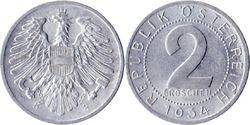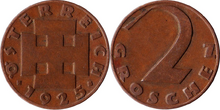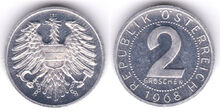| 2 groschen | |
|---|---|

| |
| 1954 coin | |
| General information | |
| Country | |
| Value |
0.02 schilling |
| Years |
1925–1994 |
| Measurements and composition | |
| Mass |
|
| Diameter |
|
| Thickness |
|
| Composition |
|
| Appearance | |
| Shape |
round |
| Alignment |
medallic |
| Edge |
plain |
| Obverse |
|
| Reverse |
|
| v · d · e | |
The 2 groschen coin is a former circulation piece of the Republic of Austria. It was issued in two types by the Austrian National Bank (German: Oesterreichische Nationalbank) from 1925 to 1994, one under the First Austrian Republic and Federal State of Austria and the other under Allied-occupied Austria and the current Second Republic. Both coins were struck at the Vienna Principal Mint (known as the Austrian Mint from 1989).
The first coin of the denomination, part of the first Austrian schilling, was struck from 1925 to 1938 under the First Austrian Republic and Federal State of Austria. Prior to its eventual demonetization, the piece carried a legal tender face value of 0.02 schilling in its country of origin. For a short period after the Anschluss (1938), the annexation of Austria into Nazi Germany, the coin was valued at about 0.01 Reichsmark.
During the Allied invasion of Germany in World War II (1939–1945), Austria was occupied by American, British, French, and Soviet forces. This occupation lasted until 1955, when Austria was accorded full independence and the current Second Austrian Republic was formed. In 1950, during the Allied occupation, a new 2 groschen piece was introduced under the second Austrian schilling. From then, it was produced in circulation quantities until 1991, and in collectors' sets until 1994. Prior to its demonetization on December 31, 2001, shortly before the introduction of the first euro coins, the piece carried a legal tender face value of 0.02 schilling in its country of origin. It remains exchangeable for €0.0015 at any branch of the Austrian National Bank.
Coins[]
Coin of the first schilling (1925–1938)[]

1925 coin
With the passage of the Schilling Act (German: Schillingrechnungsgesetz) on December 20, 1924, the first Austrian schilling was established, replacing the Austrian krone at a rate of 1 schilling to 10,000 krone. The first series of coins of the new currency, consisting of denominations of 1, 2, and 10 groschen and ½ and 1 schilling, was first struck from 1924 to 1925. These pieces were subsequently followed by the first 5 and 50 groschen and 2, 5, 25, and 100 schilling coins in the late 1920s and early 1930s. The 2 groschen piece, which was struck from 1925 to 1938, was released into circulation on March 1, 1925, and demonetized after the Anschluss in 1938. Its designs, the work of Austrian sculptor Philipp Häusler (1887–1966), are similar to those of the Austrian 200 krone coin, which was introduced in 1924 to ease the transition from the krone to the schilling.
The 2 groschen coin, like the earlier 200 krone piece, is composed of a bronze alloy of 95 percent copper, 4 percent tin, and 1 percent zinc and measures 3.3 grams in mass, 19 millimeters in diameter, and 1.4 millimeters in thickness. It has medallic alignment and a plain edge, and like most coins, is round in shape. The rims of both sides of the piece are raised and undecorated.
A thick cross potent (☩), a national symbol of the First Austrian Republic, is illustrated in the center of the obverse. The German name of Austria, "ÖSTERREICH", is written above, extending clockwise from the coin's lower left to lower right peripheries. Printed in the opposite direction at the bottom of the piece, below the cross, is the Gregorian date of minting. It is separated from the aforementioned text by two small diamonds, one at each side of the obverse.
The face value "2 GROSCHEN" solely appears on the reverse. The numeral "2" is rendered horizontally in thick print in the center of the piece, while the following word is inscribed counterclockwise at the rim below.
According to the Standard Catalog of World Coins, approximately 109,993,000 examples of the coin were manufactured over its 11 years of production. Only business strikes of this particular type are known to exist.
| Mintages | |
|---|---|
| Year | Mintage |
| 1925 | 30,292,000 |
| 1926 | 17,137,000 |
| 1927 | 8,722,000 |
| 1928 | 18,758,000 |
| 1929 | 16,184,000 |
| 1930 | 5,709,000 |
| 1934 | 812,000 |
| 1935 | 3,287,000 |
| 1936 | 4,657,000 |
| 1937 | 3,571,000 |
| 1938 | 864,000 |
| Total | 109,993,000 |
Coin of the second schilling (1950–1994)[]

1968 proof coin
In 1938, German Chancellor Adolf Hitler (1889–1945; i.o. 1933–1945) declared Anschluss with Austria, thereby annexing the Central European country into Nazi Germany. As part of Germany, Austria was invaded by Allied forces in 1945, during the final months of World War II in Europe. It was subsequently partitioned into four occupation zones administered by France, the Soviet Union, the United Kingdom, and the United States, and was then accorded full independence in 1955.
The Austrian schilling was reintroduced in 1945, during the first year of the Allied occupation. Initially, only banknotes were issued for the new currency, but in 1947 the first coins, denominated at 10 and 50 groschen and 1 and 2 schilling, were introduced. These were subsequently followed by 1, 2, 5, and 20 and 5 and 10 schilling pieces into the late 1940s and 1950s. The 2 groschen coin, introduced on July 15, 1950, was manufactured in circulation quantities until 1991, and for collectors' sets until 1994. It was eventually demonetized on December 31, 2001, shortly before the introduction of the first euro coins.
The 2 groschen piece is composed of an alloy of 98.5 percent aluminum and 1.5 percent magnesium and measures 0.9 grams in mass, 18 millimeters in diameter, and 1.6 millimeters in thickness. It has medallic alignment and a plain edge, and is round in shape. Both of the coin's rims are raised and undecorated.
The obverse, designed by Austrian sculptor Michael Powolny (1871–1954), features the coat of arms, or Bundesadler (Federal Eagle) of the Second Austrian Republic in its center. Such a depiction, which consists of a single-headed eagle crowned with a mural crown, is shown holding a sickle in its dexter talon and a hammer and in its sinister talon. Both talons are shackled with broken chains, symbolizing Austria's liberation from Germany, and the eagle's breast is superimposed by an escutcheon bearing the Austrian tricolor.
The coin's reverse, designed by Austrian artist Benno Rost, displays the face value "2 GROSCHEN" in its center, inside a circular beaded boundary. In this value, the numeral "2" is engraved in significantly larger print than the following word. Printed clockwise from the coin's lower left to lower right peripheries, outside the circular border, is the German state title of the Republic of Austria, "REPUBLIK ÖSTERREICH". The Gregorian date of minting appears in the opposite direction at the bottom of the piece.
The Standard Catalog of World Coins reports that over nearly 45 nonconsecutive years of production, more than 210,364,000 examples of the coin were manufactured, including business strikes, proofs, and special uncirculated pieces. Mintage figures for proofs minted from 1950 to 1966 are not included in the popular catalog. Examples were included in official mint and proof sets by the National Bank of Austria.
| Mintages | |
|---|---|
| Year | Mintage |
| 1950 | 21,652,000 |
| 1950 Proof | Unknown |
| 1951 | 7,377,000 |
| 1951 Proof | Unknown |
| 1952 | 37,851,000 |
| 1952 Proof | Unknown |
| 1954 | 46,167,000 |
| 1954 Proof | Unknown |
| 1957 | 26,923,000 |
| 1957 Proof | Unknown |
| 1962 | 6,692,000 |
| 1962 Proof | Unknown |
| 1964 | 173,000 |
| 1964 Proof | Unknown |
| 1965 | 14,475,000 |
| 1965 Proof | Unknown |
| 1966 | 7,454,000 |
| 1966 Proof | Unknown |
| 1967 Proof | 13,000 |
| 1968 | 1,803,400 |
| 1968 Proof | 21,600 |
| 1969 Proof | 57,000 |
| 1970 Proof | 260,000 |
| 1971 Proof | 145,000 |
| 1972 | 2,763,000 |
| 1972 Proof | 132,000 |
| 1973 | 5,883,000 |
| 1973 Proof | 149,000 |
| 1974 | 1,387,000 |
| 1974 Proof | 93,000 |
| 1975 | 1,096,000 |
| 1975 Proof | 52,000 |
| 1976 | 2,755,000 |
| 1976 Proof | 45,000 |
| 1977 | 1,837,000 |
| 1977 Proof | 47,000 |
| 1978 | 1,527,000 |
| 1978 Proof | 44,000 |
| 1979 | 2,434,000 |
| 1979 Proof | 44,000 |
| 1980 | 1,893,000 |
| 1980 Proof | 48,000 |
| 1981 | 950,000 |
| 1981 Proof | 49,000 |
| 1982 | 3,950,000 |
| 1982 Proof | 50,000 |
| 1983 | 2,665,000 |
| 1983 Proof | 65,000 |
| 1984 | 500,000 |
| 1984 Proof | 65,000 |
| 1985 | 1,064,000 |
| 1985 Proof | 45,000 |
| 1986 | 1,798,000 |
| 1986 Proof | 42,000 |
| 1987 | 958,000 |
| 1987 Proof | 42,000 |
| 1988 | 1,061,000 |
| 1988 Proof | 39,000 |
| 1989 | 950,000 |
| 1989 Proof | 38,000 |
| 1990 Proof | 35,000 |
| 1991 | 2,600,000 |
| 1991 Proof | 27,000 |
| 1992 Uncirculated | 25,000 |
| 1993 Uncirculated | 28,000 |
| 1994 Uncirculated | 25,000 |
| Total | > 210,364,000 |
References[]
- Numismatic Guaranty Corporation – Austria - 2 Groschen, KM# 2837 (1925–1938) • Austria - 2 Groschen, KM# 2876 (1950–1994)
- Colnect – 2 Groschen (1925–1938) • 2 Groschen (1950–1994)
- Numista – 2 Groschen (1925–1938) • 2 Groschen (1950–1994) (English) (French)
Österreichischer Schilling on the German (Deutsch) Wikipedia
Austrian krone on the English Wikipedia
Austrian schilling on the English Wikipedia
Template:Austrian schilling
